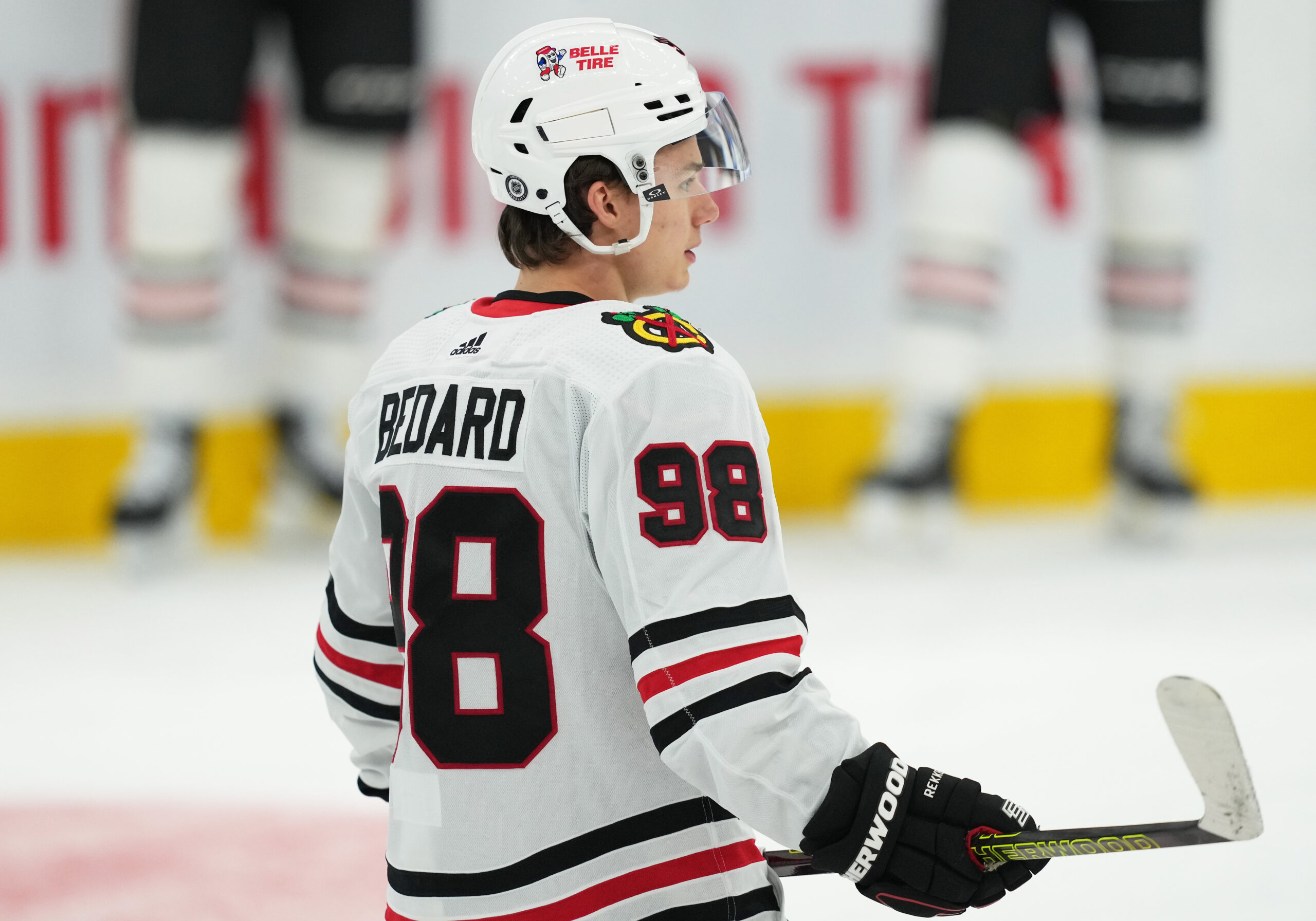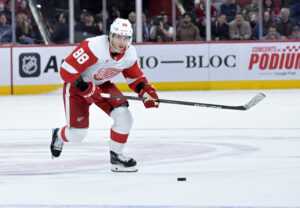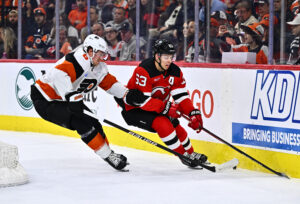Welcome back to Top Shelf Prospects, the column that brings you the next crop of professional hockey players. As we go through the summer of 2023, each day our LWOS Prospects Writers will bring you a look at one NHL team’s top prospects or other topical article. Be sure to bookmark the site, follow Ben Kerr, Kyle Pereira and Frederik Frandson on Twitter, and spread the word for the site that will bring you analytical and critical profiles and scouting reports! You can find all the articles here as well as our extensive NHL Draft preview. In our new series, we look at the Top 100 NHL prospects! Today, we look at the top 25 prospects.
100-76, 75-51, and 50-26 are found at these links.
Top 100 NHL Prospects: The Top 25
25.) Juraj Slafkovsky
At his best, Slafkovsky is a power forward. He uses his size and skill to his advantage. He can become a puck-possession monster. Slafkovsky is a very good stick-handler and uses his long reach and big body to protect the puck down low in the cycle game. When he gets the opportunity, he can take the puck to the front of the net and finish in tight to the goal with his soft hands. He also has a very good shot. His one-timer is powerful and accurate. His wrist shot also has good power and accuracy. He gets it off with a quick release that helps to fool goaltenders from further out. Slafkovsky has an intriguing combination of size and ability. He could become a dominant NHL winger.
24.) David Reinbacher
A strong skater, Reinbacher can start the rush up the ice or make a smart pass to a teammate to advance the transition game. In the offensive zone, his stickhandling allows him to control the puck and open up passing and shooting lanes. He has good vision and the ability to set up teammates for scoring chances. His skating ability also allows him to be strong in the defensive end. He maintains good gap control and forces attackers to the outside and away from prime scoring areas. Reinbacher plays a physical game. He’s not a huge hitter but will use his size to take his man out of the play. He is also willing to take a hit to make a play.
23.) Dylan Guenther
Guenther is a threat both with and without the puck. He has good hands and can handle the puck and make plays while moving at top speed. He has very good vision and the passing skills to be a playmaker off the rush, or in the offensive zone. Quick movements of his feet and hands allow him to get past defenders off the rush as well as to create passing and shooting lanes in the offensive zone. His ability to control the play also allows his teammates the time to get open. Once they do, he can find them with a pass through a tight area in order to set up a scoring chance.
22.) Jiri Kulich
Kulich is an excellent goal scorer, especially in between the hash-marks, in the “home plate” area of the ice. He has a knack for getting himself open in these areas and taking a pass from a teammate and firing the puck on the net. His wrist shot is extremely powerful and accurate. It also features a quick and deceptive release. Kulich also has a good snapshot and can even score with his backhand. He can also score in tight to the goalie with his ability to quickly elevate the puck. Kulich plays in the dirty areas of the ice and can bang in rebounds and get deflections as well. He is especially effective in playing the “bumper” position on the power play.
21.) Will Smith
Smith is a very good skater and this allows him to play a very creative game. He has very good speed and is able to create off the rush. His acceleration is also excellent. This allows him to win races to loose pucks. It also allows Smith to go wide on a defender and drop his shoulder, cutting to the front of the net. His ability to change speeds in the neutral zone creates openings and allows him to gain the line and effectively establish puck possession in the offensive zone. Smith also has very good edgework and agility. This makes him a real challenge for defenders to contain in one-on-one situations. Smith has good balance and does well along the boards and in front of the net. This area of his game should continue to improve as he adds muscle to his frame.
20.) Matthew Knies
Knies is a very creative player. He can stickhandle in tight spaces and extend plays for teammates to get open. With his hands and agility, he can beat defenders in tight spaces. Knies loves to take the puck to the front of the net. Knies also protects the puck well down low in the cycle game. He also has the passing skills to get the puck through tight areas and find an open teammate for a scoring chance. Knies can also score goals. He is strong in front of the net and creates issues for goalies when he gets there. He is willing to go to the net without the puck and fight for position, tip-in teammates shots, and pounce on rebounds. Knies also has a powerful wrist shot with good accuracy.
19.) Yaroslav Askarov
Askarov is incredibly advanced for a young goaltender. He uses his size effectively, coming out to cut down angles and giving shooters very little net to look at. His strong legs take away the bottom of the net. They also make him an effective skater. He is able to take away those angles but still gets a good backward push, which makes him hard to deke. Those strong legs also give him a strong push and good side-to-side movement. He tracks the puck well on cross-ice passes and can get over to still make the save.
Askarov’s rebound control is very good for a young goalie, far ahead of other prospects his age. He is extremely efficient in his movements and is almost always square to the puck. This helps him to make a second save when he does give up a rebound. Askarov is also an athletic freak, with the ability to make a jaw-dropping save on those rare times when he does get caught out of position.
18.) Marco Rossi
Rossi has excellent hands and combines this with his skating ability to create offence. He can make moves while carrying the puck at top speed. He creates space by combining his quick fakes and with his quick cuts and changes in speed. Defenders have to back off to defend his speed and Rossi can take advantage of the room he has created due to larger passing and shooting lanes. He has a quick wrist shot with an excellent release. When defenders back off, he can use them as a screen and fire a shot on the net. He also has an excellent one-timer.
17.) Alexander Nikishin
Nikishin is looking like a draft steal for the Hurricanes. Playing in the KHL he has put up eye-popping offensive numbers. Nikishin can put up points with his big slap shot as well as with his playmaking ability. He skates well with the puck, generating effective zone entries. He also walks the line, opening up passing and shooting lanes. Nikishin has excellent vision and passing skills. He can find a passing lane and sets up teammates for scoring changes. Nikishin is effective both on the power-play and at even strength. His defensive game is also good. He is willing to play physically and throw big hits. He is also well-positioned, forcing attackers to the outside and away from key scoring areas.
16.) David Jiricek
Due to their struggles over the last few seasons, many of the top Blue Jackets prospects are high draft picks. Jiricek was taken sixth overall in the 2022 NHL Draft. Jiricek shows strong offensive skills. He marries his strong skating with good stickhandling. This allows him to carry the puck through the neutral zone and generate efficient zone entries. He also has the poise to control the puck at the point and make plays in the offensive zone with his good vision and passing skills. Jiricek starts the transition game with a good first pass. He shows smart decision-making and often makes a smart play. Jiricek can also be a weapon from the point. He has an excellent slapshot and one-timer, generating a lot of power on his shots.
15.) Simon Edvinsson
It is rare to find a prospect who is both 6-foot-4 and has the skating ability that Edvinsson possesses. He has a long, smooth stride that allows him to cover a lot of ground very quickly. His legs are powerful and he accelerates quickly. Edvinsson also moves quickly when skating backwards. This allows him to take offensive chances and still get back defensively. His edgework and agility are also very good. Edvinsson can make quick cuts with the puck. It also helps him to stay with attackers and maintain gap control. Edvinsson’s pivots are crisp and he transitions quickly from offence to defence and vice-versa. He skates with good leg bend and has a low centre of gravity. This helps him to be strong on the puck and win battles on the boards. As he continues to add muscle to his frame, this should only improve.
14.) Logan Stankoven
Stankoven has an outstanding wrist shot and a very quick release. He is amongst the best shooters in this draft class. His shot is powerful and accurate. He also has excellent hands. Stankoven can do a quick toe drag before shooting, leading to a change in a release point that really drives goalies nuts. A pure goal scorer, he has a real knack for finding open space without the puck. He will sneak in and avoid the defence in the high slot or near the faceoff circles. His one-timer is also very effective. Stankoven can get it off even if the pass isn’t perfect, quickly adjusting his feet and getting himself into a shooting position. He loves to shoot and will shoot from anywhere on the ice. Stankoven is also not afraid to drive the net and his quick hands can score in close.
13.) Zach Benson
Benson is a bit undersized and will need to add muscle to his frame before he is ready for the pro game. However, this is not that unusual for a 17-year-old. Despite the smallish stature, Benson is ultra-competitive, battling bigger opponents along the boards and heading to the front of the net both with and without the puck. His skating is more quick than fast. He moves around the ice well but is not a speedster. Benson is dangerous in the offensive zone though as he has quick feet and can dart in and out of tight spaces and has excellent agility to get by his man. He also handles the puck extremely well, allowing him to make creative plays. His quick stick combines with his good feet to open up passing and shooting lanes.
12.) Brandt Clarke
Clarke has great hands. He controls the puck while moving at top speed. Clarke is good at leading the rush through the neutral zone, creating odd-man opportunities. He can also move the puck with a solid first pass. Clarke is effective at gaining the zone, especially on the power play. The ability to enter the offensive zone cleanly and set things up is invaluable. Clarke has high-end vision and passing skills. He can feather the pass through a tight area. Clarke uses his mobility and quick hands to create passing lanes and set up teammates on the power play.
Clarke has an excellent wrist shot and a very good release. He shows good power and is deadly accurate. His release is quick and deceptive. He can do a quick toe-drag and get the puck off from a variety of angles, fooling goaltenders. The quick release also helps Clarke to use that shot effectively on the rush. In the zone, he also loves to sneak in from the point, letting his shot go from the top of the circles. He can use some work on his slapshot and one-timer though. As he adds muscle to his upper body, he can improve the power of his shot. In any event, Clarke has used his wrist shot far more than his slapper.
11.) Shane Wright
Wright can do it all offensively. He is a pure goal scorer with an excellent array of shots and a lightning-quick release. His wrist and snapshots are very heavy and the quick release can fool goaltenders. He also has a good one-timer. Wright has a knack for getting open and finding space to get his shot off. He also has the quick stickhandling to toe-drag the puck and open up shooting lanes. Wright can use those quick hands to score goals in tight to the net as well. He can pounce on a rebound and put it in a tight spot. He also has the hand-eye coordination to get tip-ins on teammates’ shots or to bury a quick one-timer on a pass. Wright can also deke a goalie in tight.
He also can play the role of playmaker. Wright controls the puck and speeds up the game or slows it down as necessary. His soft hands combined with his skating make him an excellent playmaker. He can make plays with the puck while moving at top speed. He also has the ability to control the puck on the cycle, giving his linemates time to get open. When they do, he can throw a tape-to-tape pass through tight passing lanes. Wright seems to see the play developing quicker than his opponents and his hockey IQ and vision are elite. He even does well to win battles on the boards and in front of the net.
10.) Lane Hutson
A second-round pick in 2022, Hutson had one of the best offensive seasons ever for a freshman NCAA defender. In order to succeed as an undersized defender, one must have dynamic skating ability. Hutson definitely has that as he is one of the smoothest and fastest skaters in his draft class. His mobility is exceptional. He has excellent speed and acceleration in both directions. Hutson can push the pace offensively and still get back into position defensively. When carrying the puck, his ability to quickly change speeds is a weapon that can fool defenders.
Hutson marries his skating with outstanding puck handling. He can lead the rush through the neutral zone, creating effective zone entries. He also creates offence off the rush with his ability to beat defenders wide and make plays. This forces defenders to back off and creates passing lanes. Hutson controls the puck extremely well in the zone. He shows poise at the blue line and can speed the play up or slow it down to create offensive chances. His vision and passing skills are excellent. When a teammate gets open, Hutson can make a quick lateral move on a defender, combining this with a quick deke in order to open up a passing lane. A very creative player, Hutson can put the puck through tight passing lanes or saucer the puck over an opponent’s stick.
9.) William Eklund
Eklund is a very smart player. He loves to slow the play down and find openings in the defence. He has very good stickhandling and puck control, as well as good balance. This allows him to control the puck in the offensive zone and wait for opportunities to pass the puck to a teammate. When that opportunity comes he can quickly thread a pass through a small area, or saucer it over a stick to set up a scoring chance for a teammate. Eklund also creates openings and passing lanes with his quick stick and excellent skating ability. If he gets a step on a defender, he is not afraid to quickly dart by him and head to the net. Eklund is not afraid to play in the dirty areas of the ice.
Eklund has a very good shot but could learn to be a bit more selfish and shoot more. His wrist shot and snapshot are both powerful and accurate. He also gets both of those shots off quickly and his deceptive release can fool goalies at times. His slapshot and one-timer could use more power though. This may come as he continues to put muscle on his frame. Eklund’s quick hands also help him to score goals in tight to the net.
8.) Simon Nemec
Nemec marries his good skating ability with strong puck-handling. He can skate the puck out of his end and can lead the rush through the neutral zone. Most of the time he uses his lateral agility and strong stickhandling to generate effective zone entries. However, there are times when he should pass the puck instead of skating the puck into multiple defenders and getting trapped. His passing skills and vision are very good. Nemec can find the open man with a smart first pass. He can also hit a streaking forward for a long breakaway pass. In the offensive zone, he quarterbacks things from the blue line. His lateral movement and puck control allow him to open up passing lanes and set up teammates for a scoring chance.
Nemec’s lateral movement also allows him to open up shooting lanes. He prefers his wrist shot to his slap shot or one-timer. Nemec likes to sneak into the top of the circles and quickly catch and shoot the puck. He could stand to add a bit more power and accuracy on his shot though. This is holding him back from being a real threat to score goals at this point. His one-timer is improving but again accuracy is a bit of an issue. He is able to avoid getting his shots blocked though. His good lateral movement allows him to open up shooting lanes and avoid defenders.
7.) Leo Carlsson
Carlsson was a standout with the Swedish team at the World Junior Championships where he put up six points in seven games. He’s also performed well playing against men in the SHL this season. Carlsson is another centre that combines size and great skating ability. His smooth stride and good speed allow him to play a 200-foot game. He also has excellent stickhandling ability, allowing him to transition the puck through the neutral zone and find clean and efficient zone entries. Once there, Carlsson has excellent vision and playmaking ability. Carlsson can control the puck down low, maintaining possession and giving his teammates time to get open. When they do, he can fire a pass through a tight passing lane and set up a scoring chance.
His shot is hard but he could get a little quicker with his release. He is also able to score goals by driving the net. Carlsson can beat a goaltender with a quick deke in tight, banging in a rebound, or making use of his strong hand-eye coordination to get deflections. With his size, Carlsson can also create havoc and effectively screen goalies. Carlsson is willing to play a gritty game as well. He gets in quickly on the forecheck, forcing turnovers and creating offence that way. He is also willing to work hard on the backcheck and is effective defensively for his age.
6.) Jesper Wallstedt
At 6’3″ Wallstedt has decent size for a modern goalie prospect but is not going to be confused with the giants drafted in recent years either. His rebound control is very good for a young goalie, far ahead of other prospects his age. Wallstedt swallows up a lot of shots and just doesn’t give rebounds. He is also extremely efficient in his movements and is almost always square to the puck. This helps him to make a second save when he does give up a rebound. He is pretty good at angling pucks to the corners when he can’t swallow them.
Wallstedt’s technique is incredibly advanced for a young goaltender. He uses his size effectively, coming out to cut down angles and gives shooters very little net to look at. His strong legs take away the bottom of the net. They also make him an effective skater. He is able to take away those angles but still gets a good backward push, which makes him hard to deke. Those strong legs also give him a strong push and good side-to-side movement. He tracks the puck extremely well on cross-ice passes and can get over to still make the save.
Wallstedt is also good at handling the puck and making a pass to set up the breakout. He often acts like a third defenceman for his team, quickly moving the puck to his defenceman and helping the transition game. If the opposing team gets caught on a line change, he can make a long pass to create an odd-man rush for the forwards.
5.) Logan Cooley
Cooley marries his outstanding skating with excellent puckhandling ability. This allows him to control the puck and make plays off the rush and at top speed. He also is able to control the puck in the offensive zone, speeding up the play or slowing it down as necessary. His patience and poise are combined with outstanding vision. He is able to wait for his teammates to get open and then feather a tape-to-tape pass through a tight passing lane to set up a scoring chance. His lateral mobility and his quick hands also allow Cooley to make quick moves to open up those passing lanes. Cooley’s vision and high-end IQ, allow him to quarterback the powerplay from the half boards.
While Cooley is best known for his playmaking ability, he can also score goals. He has a very good wrist shot. It is powerful and accurate. He also has a lightning-quick release that can fool goaltenders. His soft hands also allow him to score in close, pouncing on rebounds, banging in a pass from a teammate, deflecting in a shot, or deking the goalie. Cooley is a creative player who will try a between the legs pass or other fancy move that others wouldn’t dream of. He even pulled off “the Michigan” or a lacrosse-style goal at the Under-18s.
4.) Luke Hughes
Hughes has the ability to run the power play from the point. With his soft hands, he maintains good puck control. His quick feet and ability to toe-drag with the puck help him to make quick moves that open up passing and shooting lanes. He has good vision and when he gets the opportunity he can find an open teammate to set up a scoring chance. His ability to control the play and speed things up or slow them down allows his teammates time to get open. Hughes also has a very good slap shot and one-timer. He does a good job of moving his feet and finding open space without the puck, allowing him to find shooting lanes and get the puck on the net. Hughes understands how to keep the puck low and on the net, allowing teammates to get rebounds and deflections.
Hughes also has a good wrist shot and quick release. He can sneak in from the line and let that shot go from the top of the face-off circle. He also uses it effectively as a trailer on the rush. Hughes can avoid forecheckers and skate the puck out of the defensive zone. He also makes a good first pass to get the puck up to the forwards. He can also make the long breakaway pass if a forward is free. Hughes can also carry the puck through the neutral zone and create effective zone entries. However, he does not do this as often as his brother Quinn, preferring to move the puck up the ice and play the role of the trailer.
3.) Adam Fantilli
The 3rd overall pick in the 2023 Draft, Fantilli had a dominant freshman season at the University of Michigan. Fantilli has the size and skating to be the type of powerful, two-way centre that every NHL team covets in their top six. He drives through the dirty areas of the ice both with and without the net. Fantilli puts pressure on the defence by taking the puck to the net, getting to the net without the puck, and forechecking effectively when the opponent has the puck. He is a threat to score goals and make plays for teammates. Fantilli also plays a responsible defensive game.
Fantilli is the prototype of the power forward/centre that teams look for. He can score goals, set up teammates and control the game in the middle of the ice. Fantilli has very good vision and anticipates the movements of teammates. When they get open, he can hit them with a tape-to-tape pass to set up a scoring chance. He also has the ability to score goals both by driving the net and with a hard and accurate shot. His release is quick and deceptive and can cause issues for goalies.
2.) Matvei Michkov
Once seen as the undisputed number two pick behind Bedard, Michkov slipped a little in the NHL Draft. A huge part of that is the political situation (re: war with Ukraine) in Russia and how that will affect getting young Russian players out of the country and into the NHL. Add in the fact that he is signed with SKA St. Petersburg, one of the best and richest teams in Russia through the end of the 2025-26 season and it will take a bold team to draft him in the top three of this draft. Some of this dropoff is also due to circumstances with SKA.
Michkov is a pure goal scorer. He has a knack for scoring goals in a variety of ways. This includes an excellent array of shots (wrist shot, snap shot, slap shot, one-timer, backhand) and a very quick release. He understands how to get open and to put himself in good positions to take a pass from a teammate and fire it on the net. Michkov also has great hands and stickhandling ability. He can create his own shot and get the puck in tight to the net to make a play. While he could stand to add some muscle as well as work on his all-around game, those are things that can be worked on. The goal-scoring skill, at the level he possesses it, cannot be taught and makes him an elite-level prospect in this stacked draft.
1.) Connor Bedard
Bedard’s skating is good but not generational like Connor McDavid. Instead, he excels in other areas. Bedard’s hockey sense is off the charts. He reads the play extremely well and always seems to be one step ahead of both his opponents and teammates. He has a knack for finding open ice, even when everyone on the ice is watching him. His shot is already at an elite NHL level. Bedard is a pure goal scorer. His release is extremely quick and goalies find it very hard to read. Bedard has an excellent array of shots. While his wrist shot and snapshot are outstanding, he can also score with his slap shot and backhand. He has the hands to deke goalies and make plays in tight to the net. Excellent hand-eye coordination and quick hands allow him to tip in pucks and pounce on rebounds as well.
Bedard is also an outstanding playmaker. He sees the ice very well and anticipates the moves of both teammates and opponents. His quick hands allow him to make a move and open up a shooting or passing lane. Bedard can control the play down low, protecting the puck with his stickhandling, balance, and body control. His elite skill allows him to pass the puck to a teammate, even through traffic. He has amazing puck control and can make a play in tight spaces, such as his overtime winner in the quarterfinal against Slovakia. Bedard can do it all and it’s easy to see why so many are intrigued by his immense potential.
Bedard’s potential is off the charts. He could become the next great NHL superstar and should take over as the best player in the league when Connor McDavid starts to age out of that spot. He will be a franchise-defining player and the chances of him busting are very low. Every team in the NHL would love to have him.
Main Photo: Nick Turchiaro-USA TODAY Sports






